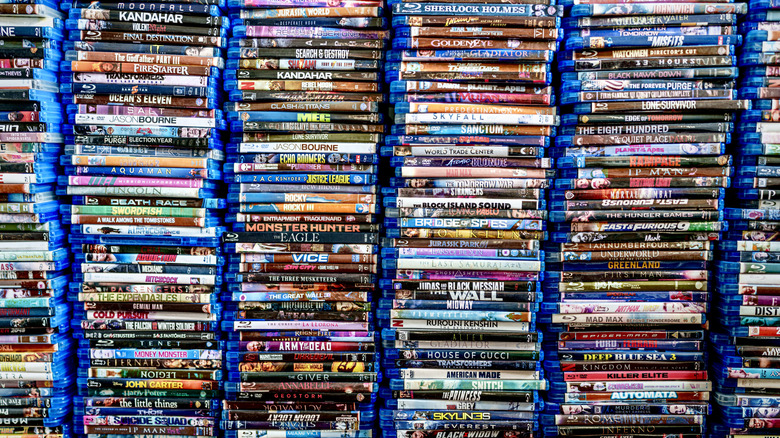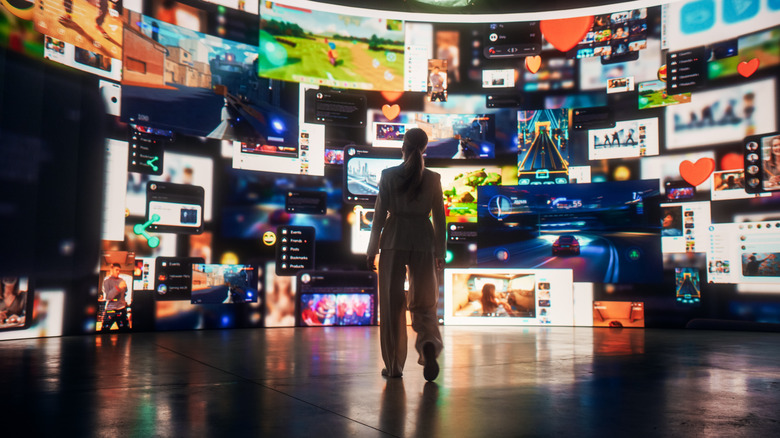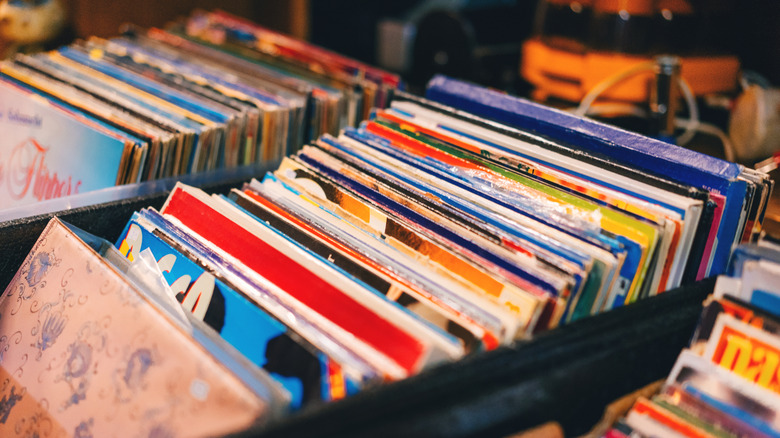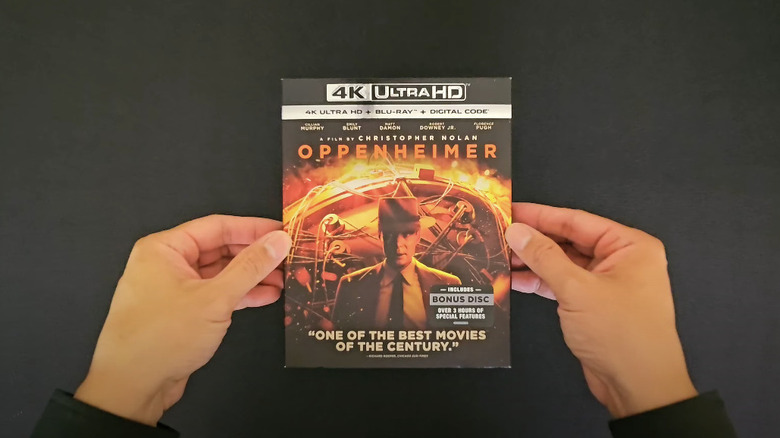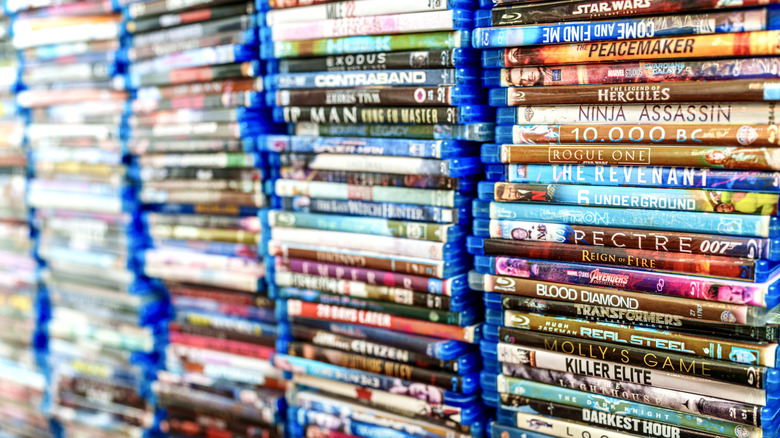The Future Of Blu-Ray Is Looking Bleak (And That's A Bad Thing For Everyone)
We may receive a commission on purchases made from links.
With over 18 years of history, Blu-ray technology was designed to take CDs and DVDs to the next level. Not only can they hold significantly more data than their predecessors, but Blu-ray discs even let you view high-quality (and 3D content) that often are closer to the experience of watching in theaters than the compressed versions you'll find elsewhere. Not to be confused with DVDs, Blu-ray discs use a different kind of laser technology, which eventually became the industry standard for film and movies by 2008. In part, this is due to the fact that its players could be backwards-compatible with DVDs, but not the other way around.
Now, the entertainment landscape has changed significantly, and Blu-ray technology is caught in the crossfire. In December 2024, LG decided to bid adieu to its UBK80 and UBK90 UHD Blu-ray players. Released only six years ago, LG joins the long list of manufacturers that have opted to deprioritize Blu-ray player manufacturing. That includes Samsung, which stopped production five years earlier. So, what does this mean for the future of Blu-ray, and how does it signal our precarious relationship with physical media?
Although some things can (and have) lasted the test of time, the natural progression of most technology is that something becomes obsolete when a newer, better, or more efficient model comes along. In terms of the Blu-ray discs, there are several things that have pushed them to obsoletion.
The decline of the Blu-ray and physical media
First, Blu-ray discs require a large and expensive distribution network. To be able to buy and sell physical copies, retailers would cover the cost of holding the inventory, displaying them on retail stores, and selling them to prospective customers. Not only does this require a lot of manpower, but there's also a risk that retailers won't sell everything in their inventories. Second, Blu-ray discs are prone to deterioration, which can happen to other forms of physical media as well. If not stored properly, they are prone to physical damage that can prevent them from working, such as scratches. And if you live in a difficult area, they're also at the mercy of natural calamities, like floods or fires. Additionally, even Blu-ray discs can rot and fall victim to mold, especially when stored in damp areas.
These days, many types of digital media have shifted to the streaming model, wherein users have a subscription to access a library. Typically, this library is a combination of content produced in-house or those licensed from other production companies. Undoubtedly, streaming has opened doors for ordinary people, who may have not had the budget to buy physical copies, like never before. Marketing-wise, you can easily watch content from all over the world or from obscure indie artists, all from the comforts of your mobile phone. So, why is killing Blu-ray a bad thing?
The impact of streaming on artists
In the past, artists were able to earn from the sales of their shows or movie box sets long after they aired. However, these days, it can be difficult to attribute which show actually draws in new subscribers, so the compensation models have evolved. Due to changes in licensing practices, many newer primary actors that have gained fame through content made by streaming platforms no longer get paid in residuals. This is a far cry from the experiences of actors from successful franchises of the past like "Friends," who still get paid millions of dollars years later. In fact, more established artists have been flagging the impact of streaming on their livelihood. In 2021, Hollywood A-Lister Scarlett Johanssen went to court because of Disney's decision to release the "Black Widow" movie from the Marvel franchise via streaming while it was still running in theaters, which she claimed significantly impacted box office sales.
Lastly, because feedback from streaming is more instant, newer productions typically aren't given the same grace of growth. These days, executives are quick to axe series that don't immediately hit their targets. Due to the changes brought about by streaming in the TV production industry, Parrot Analytics remarked that producers have been releasing series with fewer episodes. For working actors, especially those who are not household names, this can mean less stability and fewer job opportunities.
The consumer advantages of owning physical media
One of the most relatable modern frustrations for streaming subscribers is the fluctuating licensing agreements, as there's no guarantee that your favorite TV show or movie will remain on every platform forever. Unlike when you own physical media, streaming subscribers can only hope that the negotiations that happen between entertainment executives can allow them to continue to watch their comfort shows at their leisure.
We have also only begun to see the impact of modern shows on early childhood brain development. As more studies come to light, experts are recommending both less screen time and introducing less stimulating content instead. While some of these less stimulating shows can be found on streaming platforms, like Netflix, YouTube, or Amazon Prime, it's also possible that parents may want to share TV shows or movies from their youth. In some cases, these may not be licensed to any particular streaming platform but are available for lifelong use via physical disc instead.
Not to mention, keeping vintage technology alive can be incredibly useful in aging populations, wherein adoption for newer technology can be challenging. As elderly people struggle with screens or new devices, physical media like Blu-ray discs can give them a sense of normalcy and control.
How to give Blu-ray a fighting chance
When it comes to keeping any sort of vintage or old school technology alive, there is only one thing that really matters to big corporations — sales. In fact, it's what has also kept many other legacy forms of technology alive despite less people using them, even the ones that preceded the Blu-ray disc.
For example, while the verdict is still out there on whether or not vinyl actually sounds better than CDs, there's a pretty dedicated fan base who will pay a premium to get vinyl copies for their artists work. In fact, earlier this year, we dove down into the many reasons why people still prefer the older vinyl format, including the oddly satisfying ritual of taking it out of the box and the distraction-free approach to listening to music. In the same vein, we also reported how the underground music scene gave new life to floppy disks, wherein entire websites are dedicated to producing electronic music in this format.
And of course, if you want a more direct comparison, collectors have also made some VHS tapes incredibly valuable. In 2022, one of the known 27 original 1982 releases of the Star Wars: A New Hope VHS tapes (in great condition) sold for more than a hundred thousand dollars. Although there hasn't been a reported Blu-ray disc that costs this much (so far), there's a chance future collectors may decide something you can get today is worth paying for.
A resurgence of interest in Blu-ray discs
Although current sales for Blu-ray discs are a far cry from when Disney's Frozen sold over 7 million units in the U.S. alone, all hope is not lost. In 2023, renowned Mexican director behind films like Pan's Labyrinth (2017) and The Shape of Water (2017), Guillermo del Toro, shared on his X (formerly Twitter) account that "If you own a great 4K HD, Blu-ray, DVD etc etc of a film or films you love ... you are the custodian of those films for generations to come." And there seems to be a growing number of people committed to making sure their favorite movies or TV shows don't disappear in the negotiation rooms of streaming platforms.
In January 2024, BBC reported how the high-quality version of Christopher Nolan's 2023 "Oppenheimer" film practically flew off the shelves upon release. Aside from offering bonus footage, Nolan mentions that by having a physical version, people can continue to enjoy the film long after they've been removed from "evil" streaming platforms. In recent times, even the certified box office hit of the beloved musical adaptation, Wicked, announced a highly-anticipated Blu-ray disc release in 2025, according to the Wrap.
While you can't do much about corporate directives to optimize manufacturing strategies, you can support the dying Blu-ray industry in other ways, such as buying players and collecting Blu-ray discs. Should this be something you're interested in, here's how you can get started with your collection.
Where to buy Blu-ray players and discs today
Although manufacturers are not producing Blu-ray players, there are still tons of brand new models available for sale. Priced at $85.99, one popular option on Amazon is the GEOYEAO Blu-ray player, which has an average of 4.4 stars from over a thousand people. On eBay, you can get a brand new LG BP350 Blu-ray Disc & DVD player for $79.99 for your home or an older Panasonic Blu-ray disc player still in the box, which starts at $64.99. Although, some people might have forgotten that many consoles, such as the Sony PS3/PS4 and the Xbox One can also play Blu-ray discs. Should you want something for the road, there are also brand new, portable 17.6" Blu Ray players that go for around $250. Alternatively, you can buy them secondhand at your local thrift shop or check out online selling platforms. Some sellers on eBay are offering discontinued models, like the Sony UBP-X800M2 4K UHD Blu-ray player, which joins our list of 4K Blu-ray players worth buying and are usually worth less than $40.
In the past, DVDs and Blu-ray discs were staples for many large retailers. Unfortunately, that stock has dwindled. Last year, our team reported BestBuy's plans to phase out physical media in 2024. That said, there are still a lot of options for people hoping to grow their Blu-ray collection. For example, you can opt to buy Blu-ray discs from online retailers Amazon, Walmart, or Gruv.
